IMPEC: An Integrated System for Monitoring and Processing Electricity Consumption in Buildings
Abstract
1. Introduction
- Electric signals acquisition: this is the core task of NILM. It consists of measuring the aggregated electricity consumption of loads (i.e., voltage and current signals) from the utility service entry (also called whole-premises consumption).
- Feature extraction: this task consists of retrieving useful information from the acquired waveforms, such as active and reactive powers, RMS values or harmonics of signals, among others [12].
- Load disaggregation: using the features extracted, a load disaggregation process is performed by applying algorithms to aggregated consumption datasets of load signatures [13].
2. System Description
- Compactness, modularity, simplicity to install (at premises’ mains), robustness and possibility to run in headless mode (operates without a display) or via a monitor. These characteristics make it suitable for acquisition tasks at residential and industrial settings.
- A user-friendly graphical interface offering meta-data logging describing the load, and premises.
- Effective collection, management, and processing of voltage and current waveforms at different high and low sampling rates (50 kHz maximum).
- On-board data processing and feature extraction (e.g., Active power, Reactive power, etc.) at user-defined rates and time slots.
- Data logging in local storage devices (e.g., USB stick or external hard drive), or can be transmitted via Ethernet cable or wirelessly.
2.1. Hardware Description
- NI compactRIO 9063 platform: it is the core component of the system. It houses a field-programmable gate array (FPGA) responsible for high speed measurements, a real-time controller and four IO slots (see Table 2) enough for multiple voltage and current acquisitions or wireless communication modules.
- NI IO Modules: to ensure minimum intrusiveness and maximum precision and accuracy, we opted to use NI 9242 [24] for direct voltage measurements which is a suitable choice given that it has a neutral line input alongside three analog inputs making it possible to have single-phase or three-phase measurements. For current measurements, we use NI 9239 [25] appropriate for voltage output CTs, or NI 9203 [26] appropriate for current output CTs (see Table 2) at sampling rates ranging from 1 kHz up to 50 kHz.The reason behind adopting two distinct IO modules for current measurements is to guarantee an independent use of the system regardless of the chosen current sensor’s type.
- Current sensor: a number of split core (or open core) current transformer with current or voltage output can be used for current measurements (i.e., 3 CTs are used for a three-phase IMPEC, 1 CT for the single-phase). In fact, a split core CT can be easily hooked to an existing wiring without disrupting the consumption at the premises’ mains, contrary to a solid core current transformer, which has a fixed opening and a lower accuracy when compared to the former type [27]. For the time being, both IMPEC systems use SCT013 sensors from YHDC [28]. They are a series of split core (non-invasive) current transformers that have a 13 cm opening diameter (appropriate for cables found in Moroccan buildings’ mains) and that come in different input ranges. Based on preliminary measurements in residential settings, the use of a current sensor with a rated input of 100 A seems more appropriate for large households with many electric loads, where the current can reach 70 A. Similarly, a CT of 30 A rated input is more appropriate for apartments with lower power consumption. On one hand, The SCT013-000 sensor has a high rated input but performs poorly when measuring current amplitudes less than . On the other hand, sensor SCT013-030 has a lower rated input, but a higher sensitivity because it can measure (without significant distortion) amplitudes down to . Indeed, as can be noticed in the measurements in Figure 4b,c, obtained as shown in the diagram of Figure 4a, the SCT013-030 sensor succeeds at giving a better representation of low amplitude current signals (i.e., lowest total harmonics distortion) compared to SCT013-000.
2.2. Software Description
- ‘System’: it presents the hardware components of the IMPEC system (Figure 6a).
- ‘System Inputs’: as shown in Figure 6b, this is where the user specifies properties of the required acquisition task, and of the premises where the task is to be performed. In addition, this tab provides other controls such as a numerical variable to specify the duration of raw waveform snapshots to log, and seven vertical slide controls to define data processing rates at different time slots (i.e., every day of the week), providing control over sensitivity and bandwidth.
- ‘Data Acquired’: Captured data can be visualized in real-time in this tab (i.e., voltage and current waveforms, extracted features, elapsed time, and error LEDs) (see Figure 7).
2.3. Signal Acquisition
2.3.1. Energy Consumption
2.3.2. Data Synchronization
2.3.3. Data Management
2.4. Feature Extraction
- RMS of voltage signal [V]
- RMS of current signal [A]
- Active Power [W]
- Reactive Power [VAR]
3. System Testing
3.1. Single-Phase System Testing
3.2. Three-Phase System Testing
4. Incorporation of a New Task in IMPEC: Load Identification
- Classification model configuration: Support Vector Machine (SVM) or Artificial Neural Networks, in addition to their corresponding parameters (e.g., SVM’s kernel type).
- Learning datasets loading and processing: data presented as CSV files, where each row represents a signal and the last column represents its corresponding type (label).
- Model training and testing under the specified parameters and performance evaluation using four metrics (accuracy (1), precision (2), recall (3), f1 score (4)):where, is the number of the true and positive cases, is the number of the true and negative cases, is the number of the false and positive cases, is the number of the false and negative cases in the data.
- Model saving (as a JSON file) for use in online load identification.
5. Conclusion and Future Work
Author Contributions
Funding
Acknowledgments
Conflicts of Interest
References
- Lamba, G.S. Smart Grid and its Development Prospects In the Asia-Pacific Region. J. Emerg. Trends Comput. Inf. Sci. 2011, 2, 62–66. [Google Scholar]
- Jacucci, G.; Spagnolli, A.; Gamberini, L.; Chalambalakis, A.; Björksog, C.; Bertoncini, M.; Torstensson, C.; Pasquale, M. Designing Effective Feedback of Electricity Consumption for Mobile User Interfaces. Psychnol. J. 2009, 7, 265–289. [Google Scholar]
- Martin, M.; Schmidt, R.A. Communications—The Smart Grid’s Enabling Technology, Final Report; Technical Report; National Rural Electric Cooperative Association (NRECA): Arlington, VA, USA, 2014. [Google Scholar]
- Jeddi, Z.; Ghogho, M.; Bohr, A.; Botker, J.P.; Kassou, I. Estimation of Inhalation Flow Parameters for Asthma Monitoring Using Acoustic Signal Processing and Machine Learning. In Intelligent Environments 2019: Workshop Proceedings of the 15th International Conference on Intelligent Environments; IOS Press: Rabat, Morocco, 2019; Volume 26, p. 317. [Google Scholar]
- Tatsiankou, V.; Hinzer, K.; Schriemer, H.; McVey-White, P.; Beal, R. Efficient, Real-Time Global Spectral and Broadband Irradiance Acquisition. In Proceedings of the 2018 IEEE 7th World Conference on Photovoltaic Energy Conversion (WCPEC) (A Joint Conference of 45th IEEE PVSC, 28th PVSEC 34th EU PVSEC), Waikoloa Village, HI, USA, 10–15 June 2018; pp. 2362–2365. [Google Scholar]
- El Jaouhari, S.; Jose Palacios-Garcia, E.; Anvari-Moghaddam, A.; Bouabdallah, A. Integrated Management of Energy, Wellbeing and Health in the Next Generation of Smart Homes. Sensors 2019, 19, 481. [Google Scholar] [CrossRef] [PubMed]
- Hart, G.W. Nonintrusive appliance load monitoring. Proc. IEEE 1992, 80, 1870–1891. [Google Scholar] [CrossRef]
- Meziane, M.N.; Ravier, P.; Lamarque, G.; Le Bunetel, J.; Raingeaud, Y. High accuracy event detection for Non-Intrusive Load Monitoring. In Proceedings of the 2017 IEEE International Conference on Acoustics, Speech and Signal Processing (ICASSP), New Orleans, LA, USA, 5–9 March 2017; pp. 2452–2456. [Google Scholar]
- Abubakar, I.; Khalid, S.; Mustafa, M.; Shareef, H.; Mustapha, M. Application of load monitoring in appliances’ energy management—A review. Renew. Sustain. Energy Rev. 2017, 67, 235–245. [Google Scholar] [CrossRef]
- Perez, M.N.V. A Non-Intrusive Appliance Load Monitoring System for Identifying Kitchen Activities. Master’s Thesis, Escuela Politécnica Superior, Universidad Autónoma de Madrid, Madrid, Spain, 2011. [Google Scholar]
- Froehlich, J.; Larson, E.; Gupta, S.; Cohn, G.; Reynolds, M.; Patel, S. Disaggregated End-Use Energy Sensing for the Smart Grid. IEEE Pervasive Comput. 2011, 10, 28–39. [Google Scholar] [CrossRef]
- Azaza, M.; Wallin, F. Evaluation of classification methodologies and Features selection from smart meter data. Energy Procedia 2017, 142, 2250–2256. [Google Scholar] [CrossRef]
- Wittmann, F.M.; López, J.C.; Rider, M.J. Nonintrusive Load Monitoring Algorithm Using Mixed-Integer Linear Programming. IEEE Trans. Consum. Electron. 2018, 64, 180–187. [Google Scholar] [CrossRef]
- Younghun, K.; Schmid, T.; Charbiwala, Z.M.; Srivastava, M.B. ViridiScope: Design and implementation of a fine grained power monitoring system for homes. In Proceedings of the 11th International Conference on Ubiquitous Computing (UbiComp ’09), Orlando, FL, USA, 30 September–3 October 2009; pp. 245–254. [Google Scholar]
- Rowe, A.; Berges, M.; Rajkumar, R. Contactless sensing of appliance state transitions through variations in electromagnetic fields. In Proceedings of the 2nd ACM Workshop on Embedded Sensing Systems for Energy-Efficiency in Building, Zurich, Switzerland, 3–5 November 2010; pp. 19–24. [Google Scholar]
- Zico, K.J.; Matthew, J.J. REDD: A Public Data Set for Energy Disaggregation Research. In Proceedings of the Workshop on Data Mining Applications in Sustainability (SIGKDD), San Diego, CA, USA, 21 August 2011; Volume 25, pp. 59–62. [Google Scholar]
- Anderson, K.; Ocneanu, A.; Benitez, D.; Carlson, D.; Rowe, A.; Berges, M. BLUED: A fully labeled public dataset for event-based non-intrusive load monitoring research. In Proceedings of the 2nd KDD Workshop on Data Mining Applications in Sustainability (SustKDD), Beijing, China, 12 August 2012; pp. 1–5. [Google Scholar]
- Guvensan, M.A.; Taysi, Z.C.; Melodia, T. Energy monitoring in residential spaces with audio sensor nodes: TinyEARS. Ad Hoc Netw. 2013, 11, 1539–1555. [Google Scholar] [CrossRef]
- Picon, T.; Meziane, M.N.; Ravier, P.; Lamarque, G.; Novello, C.; Le Bunetel, J.C.; Raingeaud, Y. COOLL: Controlled On/Off Loads Library, a Public Dataset of High-Sampled Electrical Signals for Appliance Identification. arXiv 2016, arXiv:1611.05803. [Google Scholar]
- Meziane, M.N.; Picon, T.; Ravier, P.; Lamarque, G.; Bunetel, J.L.; Raingeaud, Y. A measurement system for creating datasets of on/off-controlled electrical loads. In Proceedings of the 2016 IEEE 16th International Conference on Environment and Electrical Engineering, Florence, Italy, 6–8 June 2016; pp. 1–5. [Google Scholar]
- Mokhtari, G.; Anvari-Moghaddam, A.; Zhang, Q.; Karunanithi, M. Multi-residential activity labelling in smart homes with wearable tags using BLE technology. Sensors 2018, 18, 908. [Google Scholar] [CrossRef] [PubMed]
- Mokhtari, G.; Anvari-Moghaddam, A.; Zhang, Q. A new layered architecture for future big data-driven smart homes. IEEE Access 2019, 7, 19002–19012. [Google Scholar] [CrossRef]
- Laughton, M.; Warne, D. Electrical Engineer’s Reference Book; Elsevier Science: London, UK, 2002. [Google Scholar]
- NI. NI 9242 Datasheet Manual; Technical Report; National Instruments: Austin, TX, USA, 2014. [Google Scholar]
- NI. NI 9239 Datasheet Manual; Technical Report; National Instruments: Austin, TX, USA, 2014. [Google Scholar]
- NI. NI 9203 Datasheet Manual; Technical Report; National Instruments: Austin, TX, USA, 2014. [Google Scholar]
- Reeves, E.; Heathcote, M. Instruments and meters. In Newnes Electrical Pocket Book; Routledge: London, UK, 2003; Chapter 18; p. 420. [Google Scholar]
- YHDC. Split Core Current Transformer (SCT-013 Model); Technical Report; Beijing Yaohuadechang Electronic Co., Ltd.: Beijing, China, 2014. [Google Scholar]
- Pressman, R. Software Engineering: A Practitioner’s Approach, 8th ed.; McGraw-Hill Education: New York, NY, USA, 2014. [Google Scholar]
- Pressman, R. Advances in Networks and Communications: First International Conference on Computer Science and Information Technology, CCSIT 2011, Bangalore, India, January 2–4 2011. Proceedings; Springer: Bangalore, India, 2010. [Google Scholar]
- Dixit, J.B.; Yadav, A. Electrical Power Quality; Laxmi Publications, Ltd.: New Delhi, India, 2010. [Google Scholar]
- Ohnhäuser, F. Basics on Delta-Sigma Converters. In Analog-Digital Converters for Industrial Applications Including an Introduction to Digital-Analog Converters; Springer: Berlin, Germany, 2015; Chapter 4. [Google Scholar]
- NI. How Can I Compensate for Different Group Delays with C Series Modules in LabVIEW FPGA; Technical Report; National Instruments: Austin, TX, USA, 2018. [Google Scholar]
- Bress, T. Effective LabVIEW Programming. In Producer-Consumer State Machines; NTS Press: Austin, TX, USA, 2013; Chapter 27; pp. 371–377. [Google Scholar]
- Gulati, M.; Ram, S.S.; Singh, A. An in depth study into using EMI signatures for appliance identification. In Proceedings of the 1st ACM Conference on Embedded Systems for Energy-efficient Buildings, Memphis, USA, 3–6 November 2014; pp. 70–79. [Google Scholar]
- Bernard, T.; Wohland, D.; Klaaßen, J.; vom Bögel, G. Combining several distinct electrical features to enhance nonintrusive load monitoring. In Proceedings of the 2015 International Conference on Smart Grid and Clean Energy Technologies (ICSGCE), Offenburg, Germany, 20–23 October 2015; pp. 139–143. [Google Scholar]
- Cohen, L. Time-Frequency Analysis; Electrical Engineering Signal Processing; Prentice Hall PTR: Bergen County, NJ, USA, 1995. [Google Scholar]
- Mathworks. Practical Introduction to Time-Frequency Analysis; Technical Report; Mathworks: Natick, MA, USA, 2018. [Google Scholar]
- Ridi, A.; Hennebert, J. Hidden Markov Models for ILM Appliance Identification. Procedia Comput. Sci. 2014, 32, 1010–1015. [Google Scholar] [CrossRef]
- Lin, Y.; Tsai, M. Development of an Improved Time–Frequency Analysis-Based Nonintrusive Load Monitor for Load Demand Identification. IEEE Trans. Instrum. Meas. 2014, 63, 1470–1483. [Google Scholar] [CrossRef]
- Biansoongnern, S.; Plungklang, B. Non-Intrusive Appliances Load Monitoring (NILM) for Energy Conservation in Household with Low Sampling Rate. Procedia Comput. Sci. 2016, 86, 172–175. [Google Scholar] [CrossRef]
- Chang, H.; Lin, C.; Lee, J. Load identification in nonintrusive load monitoring using steady-state and turn-on transient energy algorithms. In Proceedings of the 2010 14th International Conference on Computer Supported Cooperative Work in Design, Shanghai, China, 14–16 April 2010; pp. 27–32. [Google Scholar]
- Liu, H. Load Identification in Non-intrusive Load Monitoring. In Non-Intrusive Load Monitoring: Theory, Technologies and Applications; Springer: Singapore, 2020; Chapter 1; p. 13. [Google Scholar]
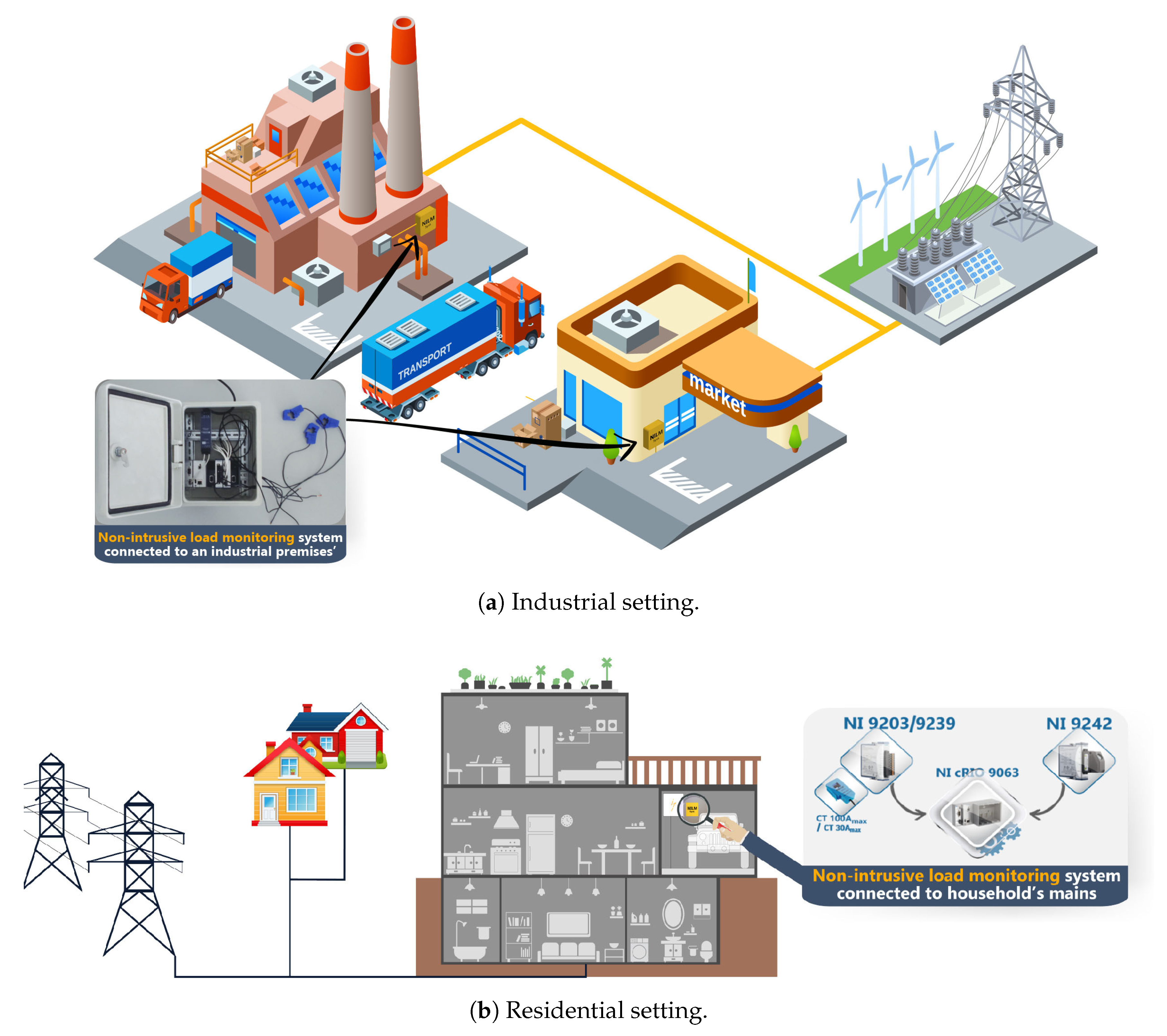
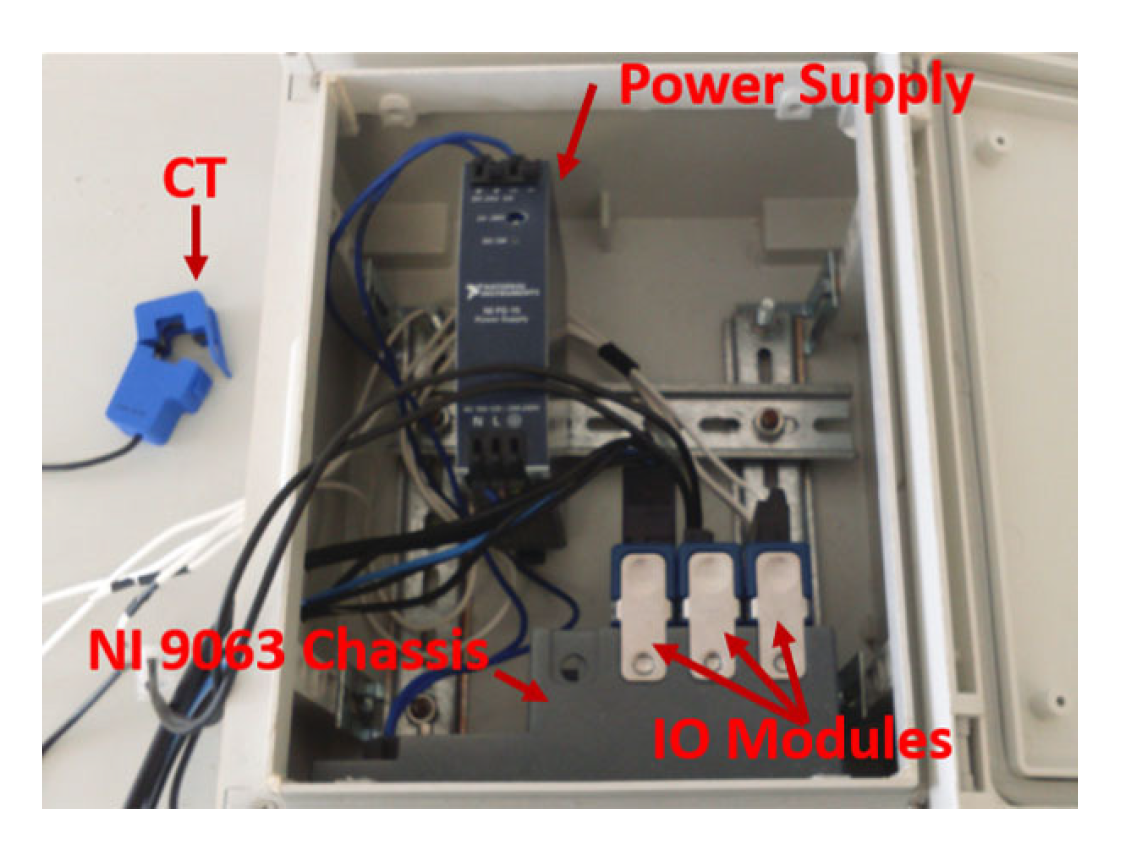



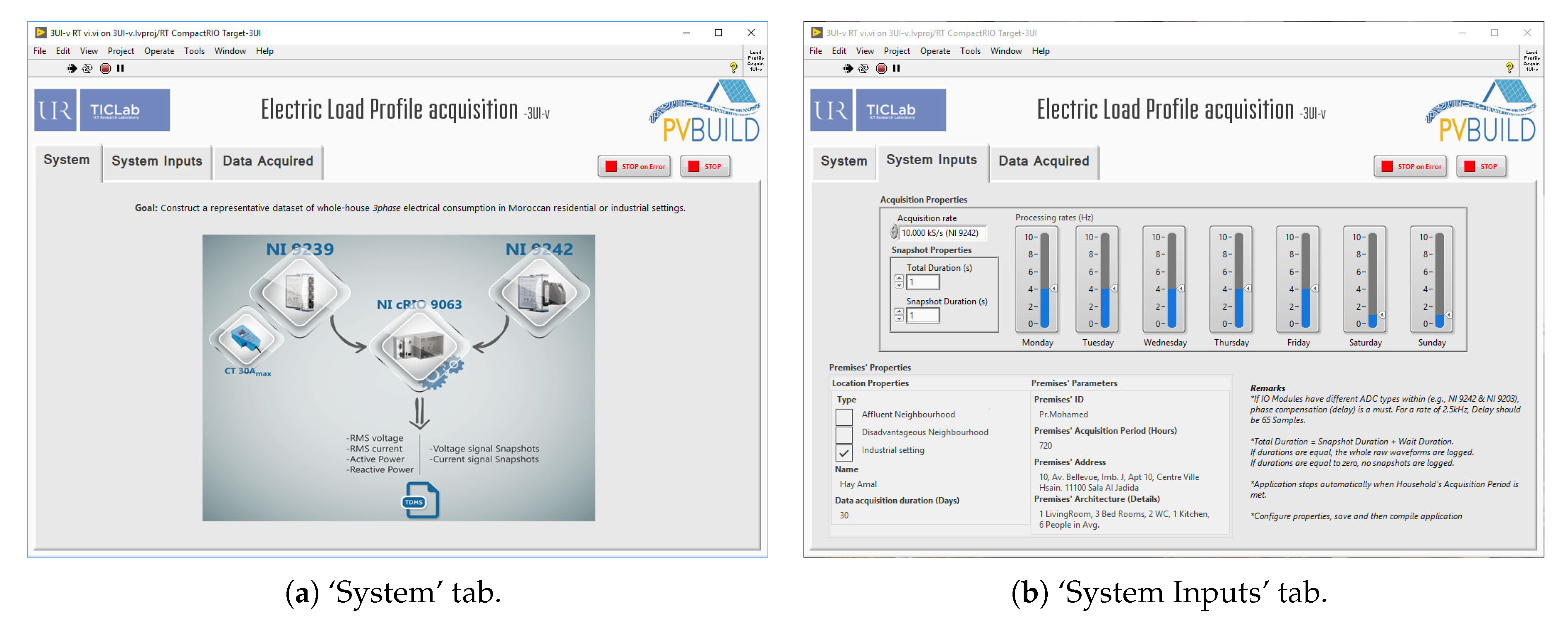

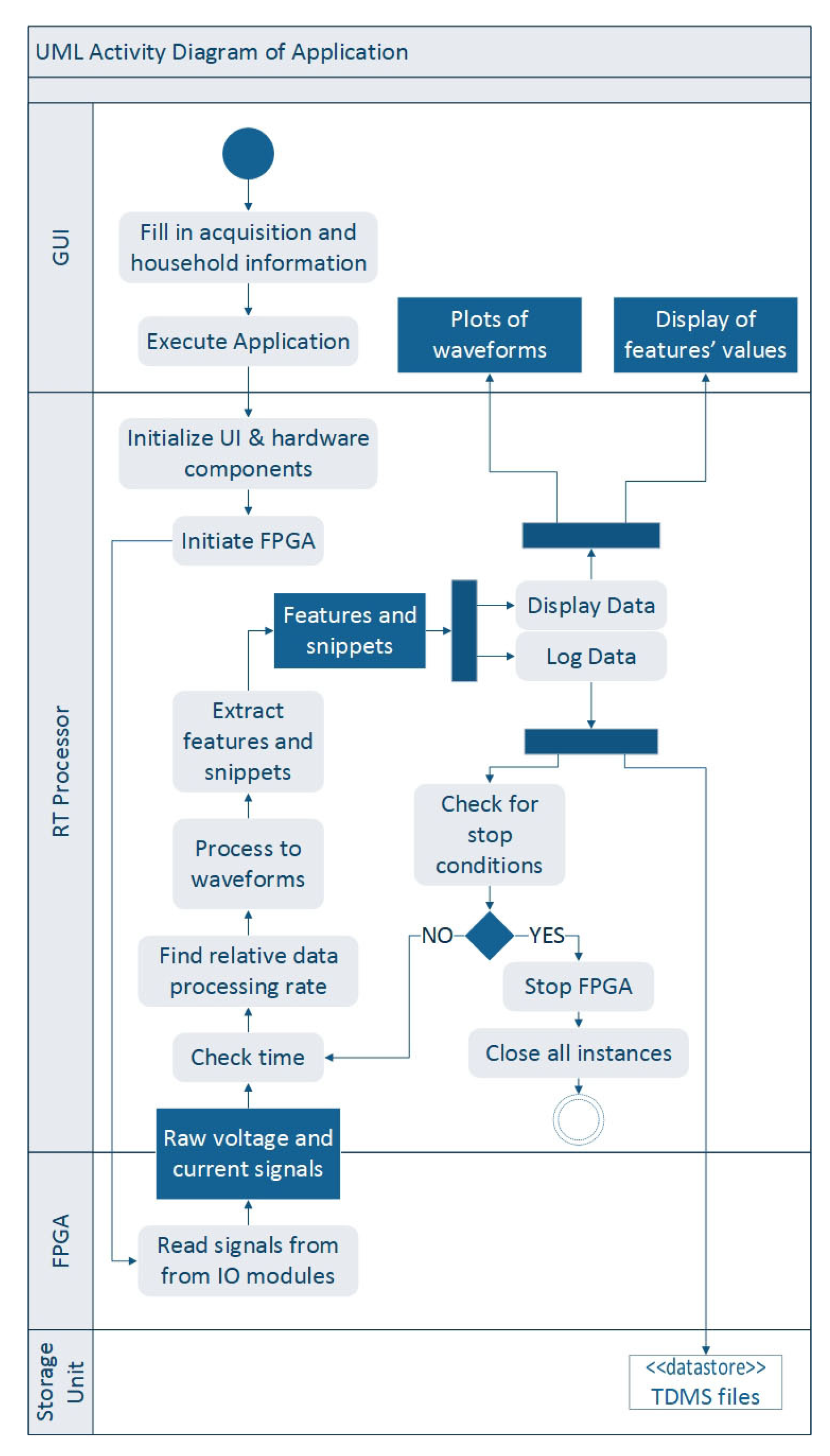
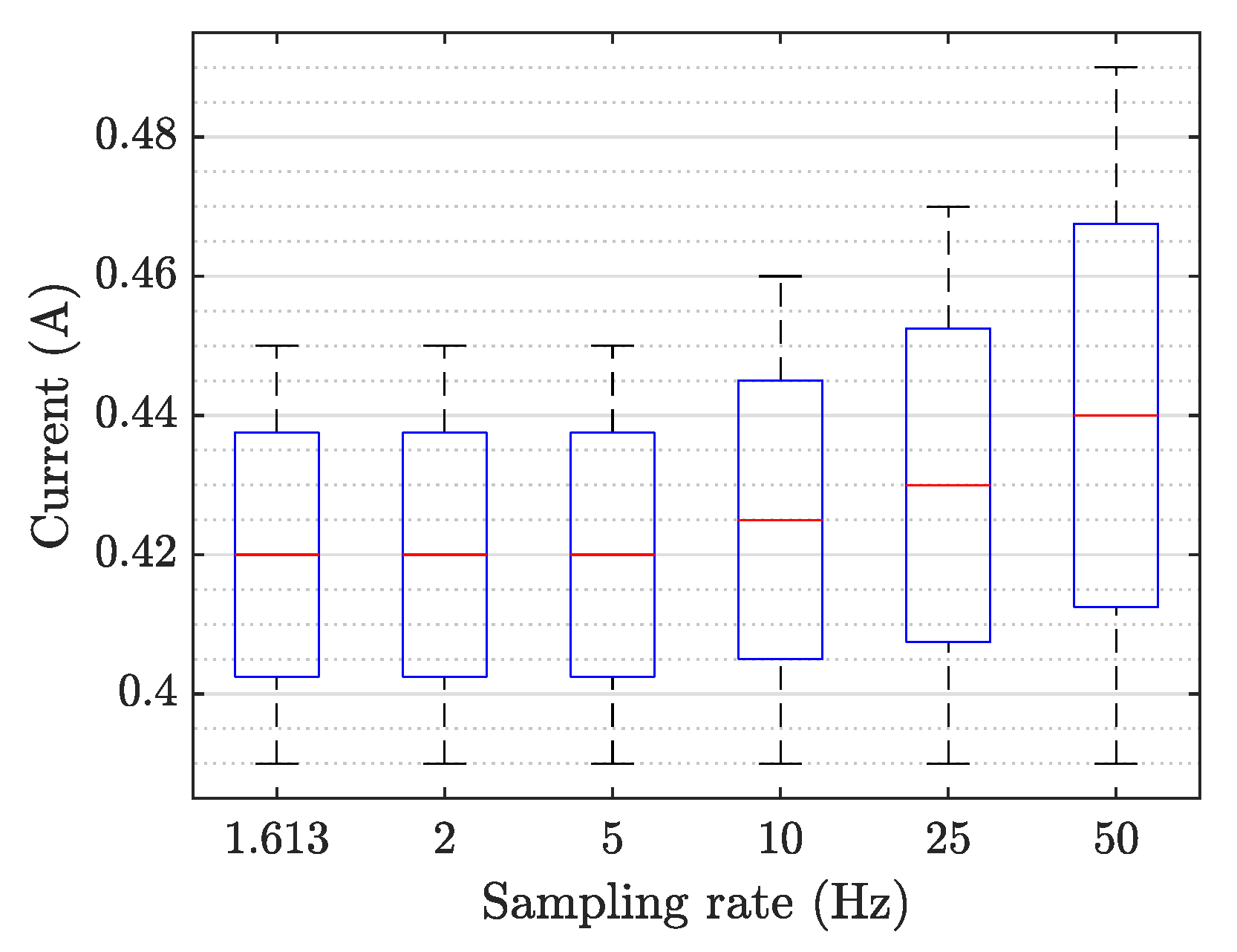

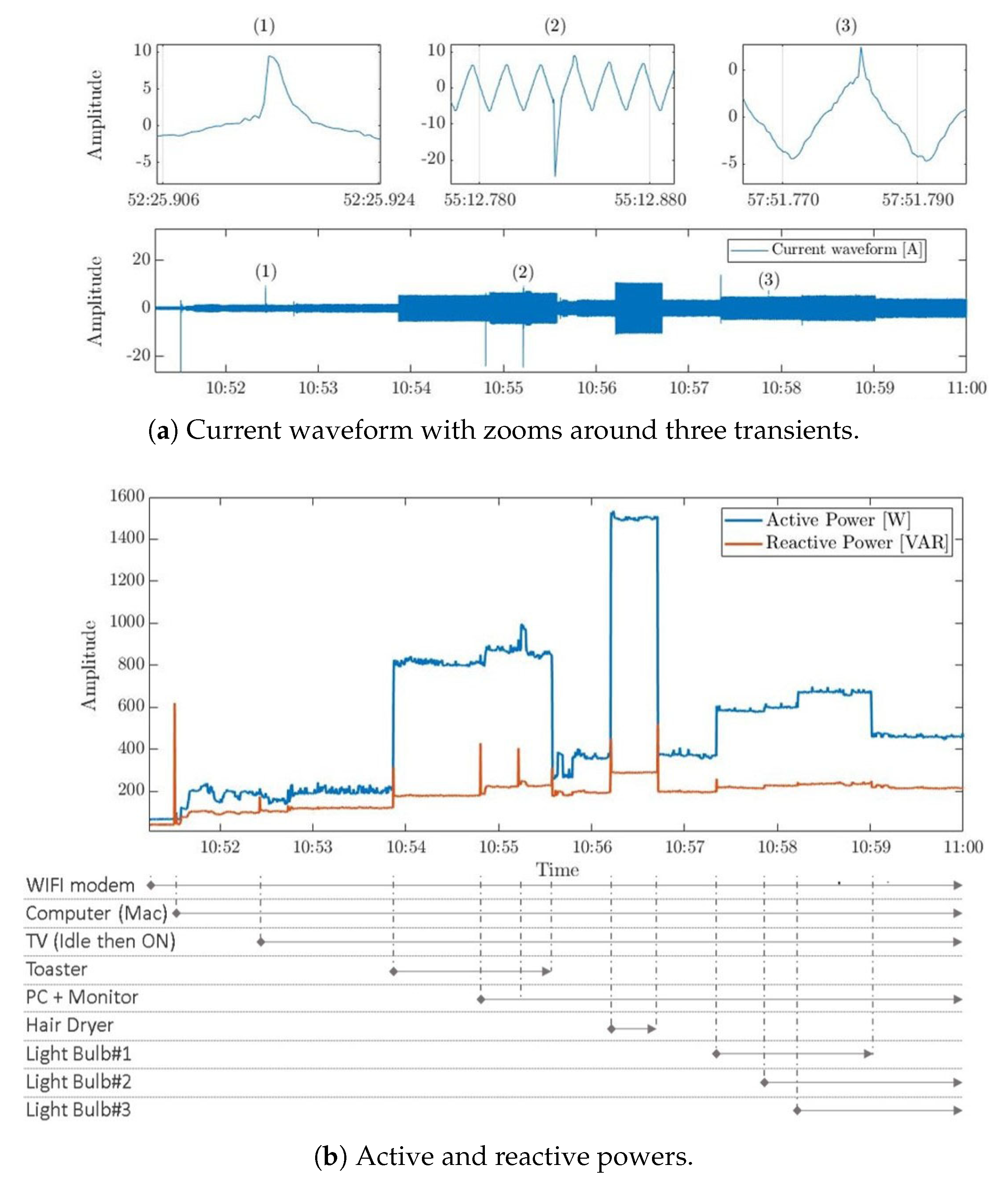


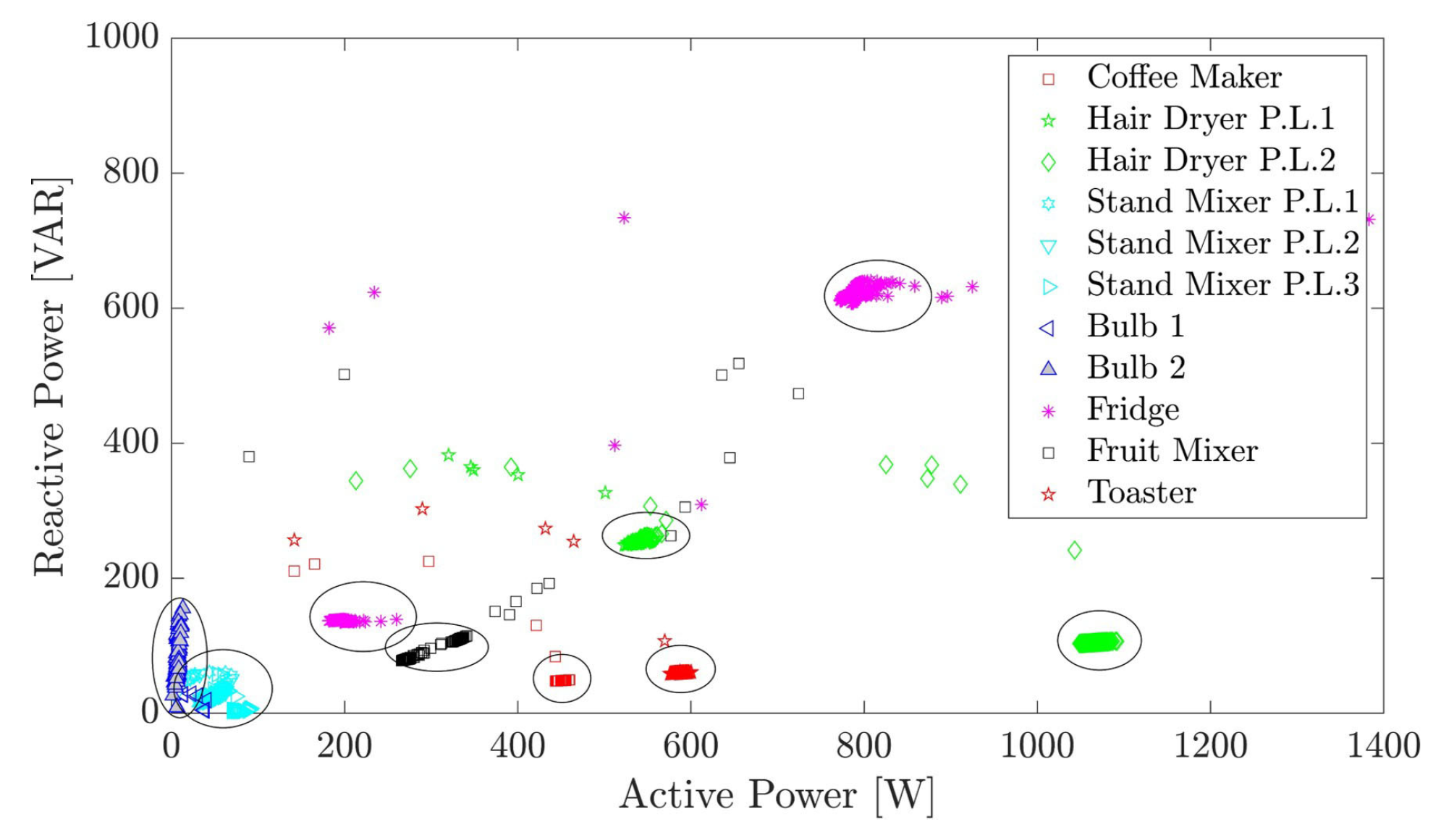

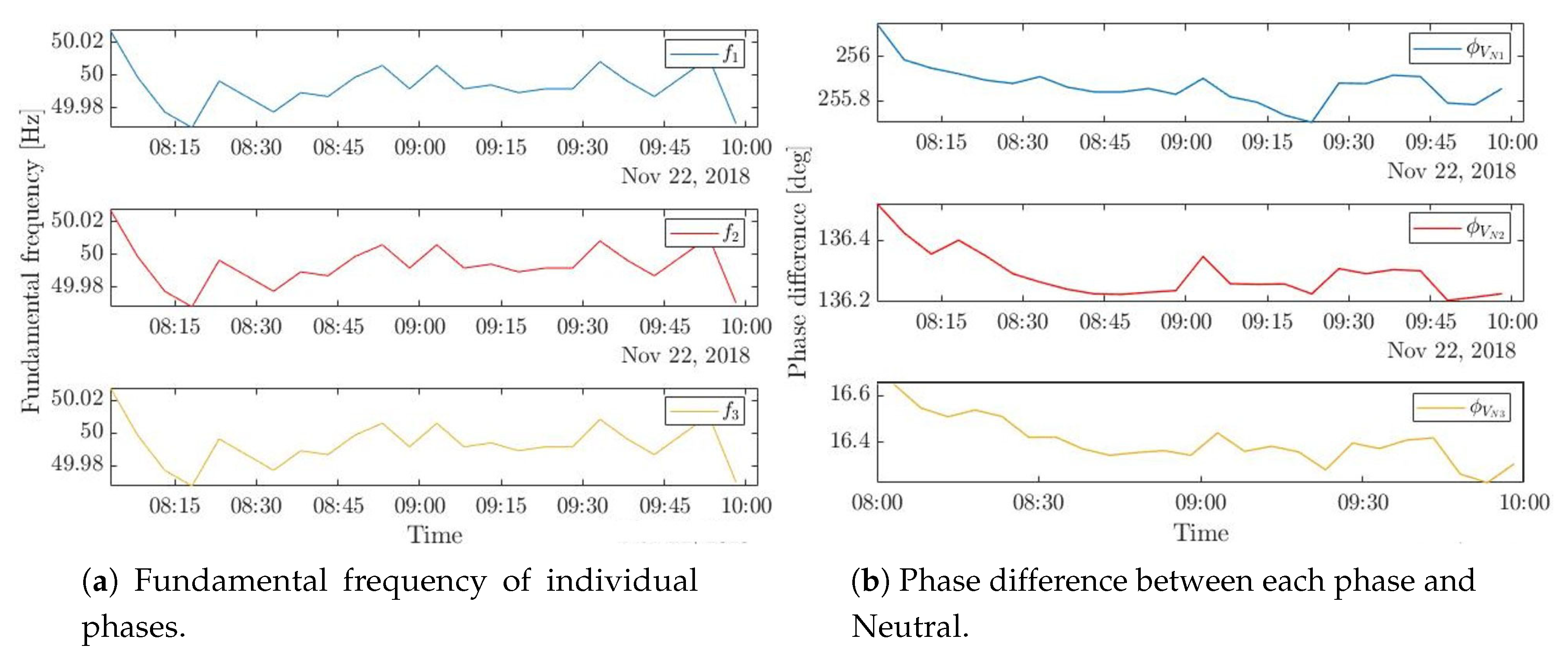

| Study | Year Published | Monitoring Type | Used Sensors | Used Features |
|---|---|---|---|---|
| [14] | 2009 | Indirect sensing | Sound sensors | Sound level, Light intensity, |
| Light sensors | Std Dev of the magnetic field | |||
| Magnetic sensors | ||||
| [15] | 2010 | Indirect sensing | Hertzian antenna | RMS of the magnetic field |
| Magnetic field sensor | ||||
| [16] | 2011 | Direct sensing | Current and voltage sensors | AC waveforms |
| [17] | 2012 | Direct and Indirect sensing | Plug-level meters Voltage transformer Current transformer Circuit panel meters Environmental sensors | Humidity, Vibration, Light level, PIR motion, Sound intensity, Barometric pressure, Active and Apparent powers, RMS of voltage and current waveforms |
| [18] | 2012 | Indirect sensing | Acoustic sensors | Spectral flux, Spectral roll-off, |
| Spectral-centroid, Band-level energy, | ||||
| Short-time energy, Zero-crossing rate, | ||||
| Mel-frequency cepstral coefficients | ||||
| [19] | 2016 | Direct sensing | Current and voltage sensors | Voltage zero-crossing, Transients in voltage and current waveforms |
| Parameter | NI 9242 | NI 9239 | NI 9203 |
|---|---|---|---|
| Channels | 3AI, 1N | 4AI | 8AI |
| Sampling rate | 50 kHz/ch | 50 kHz/ch | 200 kHz |
| ADC resolution | 24 bits | 24 bits | 16 bits |
| Test | System under Test | Setting | Target | Acquisition Period | Acquisition Rate | Extraction Rate |
|---|---|---|---|---|---|---|
| Test 1 | Single-phase | Residential | Whole-house | 10 mins | 2.5 kHz | 4 Hz |
| Test 2 | Single-phase | Residential | Whole-house | 7 days | 12.5 kHz | 4 Hz |
| Test 3 | Single-phase | Residential | Individual load | 10 s/power state/load | 25 kHz | 4 Hz |
| Test 4 | Three-phase | Industrial | Whole-premises | 7 days | 5 kHz | 6 Hz |
| Loads | Manufacturer | Rated Voltage | Rated Power | Power States |
|---|---|---|---|---|
| Stand mixer | Krups | 220 V | 140 W | FSM |
| Hair-dryer | Fagor | 220 V | 1000 W | FSM |
| Fridge | Sierra | 230 V | 140 W | FSM |
| Toaster | Fagor | 220 V | 650 W | ON/OFF |
| Coffee maker | Goodway | 220 V | 500 W | ON/OFF |
| Fruit mixer | Moulinex | 220 V | 400 W | ON/OFF |
| Bulb#1 | — | 220 V | 25 W | ON/OFF |
| Bulb#2 | — | 220 V | 40 W | ON/OFF |
© 2020 by the authors. Licensee MDPI, Basel, Switzerland. This article is an open access article distributed under the terms and conditions of the Creative Commons Attribution (CC BY) license (http://creativecommons.org/licenses/by/4.0/).
Share and Cite
Ahajjam, M.A.; Bonilla Licea, D.; Ghogho, M.; Kobbane, A. IMPEC: An Integrated System for Monitoring and Processing Electricity Consumption in Buildings. Sensors 2020, 20, 1048. https://doi.org/10.3390/s20041048
Ahajjam MA, Bonilla Licea D, Ghogho M, Kobbane A. IMPEC: An Integrated System for Monitoring and Processing Electricity Consumption in Buildings. Sensors. 2020; 20(4):1048. https://doi.org/10.3390/s20041048
Chicago/Turabian StyleAhajjam, Mohamed Aymane, Daniel Bonilla Licea, Mounir Ghogho, and Abdellatif Kobbane. 2020. "IMPEC: An Integrated System for Monitoring and Processing Electricity Consumption in Buildings" Sensors 20, no. 4: 1048. https://doi.org/10.3390/s20041048
APA StyleAhajjam, M. A., Bonilla Licea, D., Ghogho, M., & Kobbane, A. (2020). IMPEC: An Integrated System for Monitoring and Processing Electricity Consumption in Buildings. Sensors, 20(4), 1048. https://doi.org/10.3390/s20041048





